A HISTORY OF THE LIVER, SPLEEN, AND GALLBLADDER
![]()
Introduction
From the time of the famous physician Galen to those of another famous physician Harvey, there have existed a number of conceptions of the human body. The views of the human body throughout this time stayed fairly consistent, as the knowledge was based upon the work of only a few men - Aristotle, Hippocrates, and Galen. The knowledge of the liver, spleen, and gall bladder highlight the views of these men, as well as providing an insight into the conceptions of the body as a whole. There was some general agreement in the texts of Galen, Master Nicholas, Avicenna, Leonardo da Vinci, and Harvey with regard to the liver, spleen, and gall bladder. They all believed in humoral theory, and the general understanding of the aforementioned organs remained fairly consistent throughout time. For example, organs such as the spleen, liver, and gall bladder were believed to be integral to the humoral system. The inconsistencies in the physicians' descriptions of these organs can be attributed to the lack of experience that they had with the human body. Much of the knowledge that physicians such as Galen had was based upon animal dissections and theory rather than practical knowledge. For example, disagreements arose concerning the number of lobes in the liver, the consistency of the various organs, and the size and shape of each organ. The inconsistencies in their descriptions can also be attributed to the increasing number of dissections that were practiced as time passed. While some physicians decided to continue to follow the teachings of the old masters, such as Galen, others began to use evidence obtained directly from the human body in their practice of medicine.
Questions to consider: Why did physicians see the liver as having multiple lobes and why did they disagree on the number of lobes? Why was the liver viewed as such an important organ?
A Collection of Quotations from Original Sources and Images of the Liver, Spleen, and Gallbladder:
Antiquity
Galen, c.a. 200 A.D.
"The spleen serves to purify the liver"
"Nature has placed up at the liver the bladder to receive the thin, yellow residue, and she would have greatly preferred to place the spleen, which attracts the thick, muddy residue right below the port where the atrabilious residue, borne down by its own weight, would automatically sink into it. No available space, however, remained in that region, which was already entirely occupied by the stomach, and since there was plenty of room on the left, she place the spleen there."
"Now, why is the stomach surrounded by the liver? Is it in order that the liver may warm it and it may in turn warm the food? This is indeed the very reason why it is closely clasped by the lobes of the liver, as if by fingers."
"The liver is the source of the veins and the principal instrument of sanguification."
"The passages from the gall bladder have evidently been formed for separating the bile."
"For when we stand erect, the liver must be suspended from the diaphragm, and there would be considerable danger that it would be easily torn loose in more vigorous movements and the animal would die immediately, because in that region the liver is attached not only to the diaphragm but, through the diaphragm, to the heart as well."
The Middle Ages
Avicenna, 980-1037
"Though [the blood] is generated in the liver, it derives more of its heat from the heart than from the liver, the two organs being in continuity. The liver... may be looked upon as concentrated blood."
"Physicians regard the liver as the seat of manufacture of the dense part of the humors."
"The first and foremost object of observing the urine is to form an opinion about the state of the liver; the urinary passage and the blood vessels. The various disorders of these organs are revealed by it. But the most precise information to be obtained is that concerning the functional capacity of the liver."
"Natural bilious humor is the 'loam' of blood. It is bright red in colour. It is light and pungent. The redder the colour, the hotter it is. It is formed in the liver, and then pursues one of two routes-- either it circulates with the blood, or it passes on to the gall-bladder."
"All agree that the brain and the liver each receive their power of life, natural heat, and breath from the heart, and that each of them is also the starting-point of another faculty which it sends out to the other agents."
"The principal organs necessary for the life of the individual are three in number [including] the liver, the seat of the nutritive or vegetative faculties."
Master Nicolaus, ca. 1150-1200
"The stomach has the liver below it like a fire underneath a cauldron; and thus the stomach is like a kettle of food, the gallbladder is the cook, and the liver is the fire."
"The liquefaction of the juice in the liver, where the generation of the four humours takes place."
"Some say that the blood alone is generated, in form as well as substance, in the liver, the other humours are generated there in substance but in other places as to form."
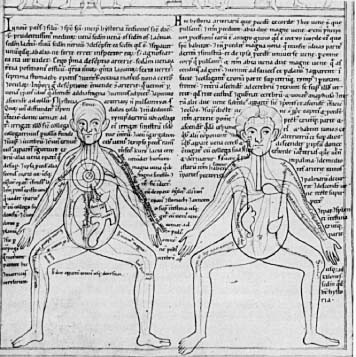
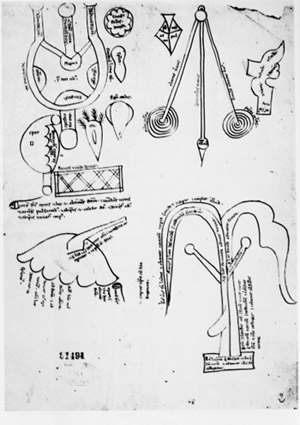
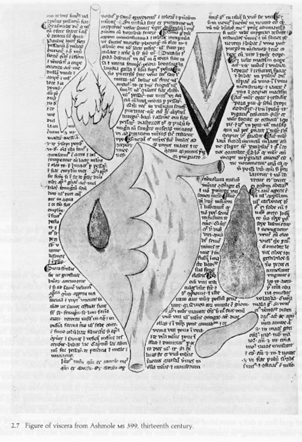
"The black bile, which is of harmful nature because of its injurious qualities and coarseness, which are hurtful to the delicate substance of the liver, is carried by its ducts to the spleen and there undergoes specific differentiation."
"The liver is warm and moist in complexion on account of the second digestion, which is performed in it. It is delicate and soft because there is much blood in its substance. In composition it is light and spongy, so that it may retain blood to promote nourishment of the body. In form it is lobate, so that its lobes may embrace the stomach and by their warmth aid the first digestion. It is hollow within, where the succositas tisanaria is collected, in order that the four humours may be formed there. It is shaped like a letter C, or like the new moon; It is the spiritual instrument of the second digestion, because the second digestion is performed in it."
The Renaissance
Berengario Da Carpi, ca. 1460-1530
Concerning the Spleen:
"It is attached to the kidney by a branch of the portal vein, to the brain by nerves, to the mesentery and omentum by veins, to the siphac (peritoneum) by a covering panniculus, and to the stomach by many veins. Some of these nourish the left part of the stomach, and one of them milks the black bile to the stomach's mouth. Its size is well known. Its complexion is set down as warm and humid, but on account of its content it is regarded as opposite (i.e. cold and dry). "
"It helps the entire body by purging the bloody mass from the feces, and therefore it provokes laughter. From time to time it makes blood, stirs the appetite, aids the digestion of the stomach, and suffers all manner of illnesses. "
Concerning the liver:
"It is large in man because he is a warm and humid animal."
"Its substance is the flesh of itself and a net of veins scattered through its texture. Its flesh is coagulated blood. It has five lobes, sometimes four and three, sometimes two."
"Its operation is blood making."
Concerning the Gall Bladder:
"The cyst of the bile or gall is called the gall bladder. It is a small bag or sack in the hollow of the liver, adhering to the latter at its middle lobe."
"Its substance is slender because it does not digest anything and hard so that it may resist the sharpness of the gall."
"It is attached to the heart by a small artery which it has and to the brain by a small nerve. Its innate complexion is cold and dry."
"Its services are to purge the blood by means of gall and to warm the digestion of the liver and to keep the latter from putrefaction. It also assists the stomach and cleanses it of phlegm. It assists the expulsion of the contents of the intestines. Sometimes a man lacks a gall bladder; he is then of infirm health and shorter life."
Leonardo da Vinci, 1452-1519 (illustrations from Da Vinci's text)
[[[[[add quotes here!!!!!]]]]]
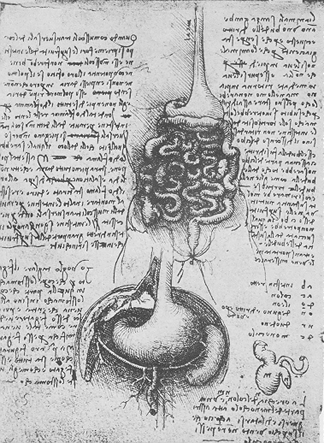
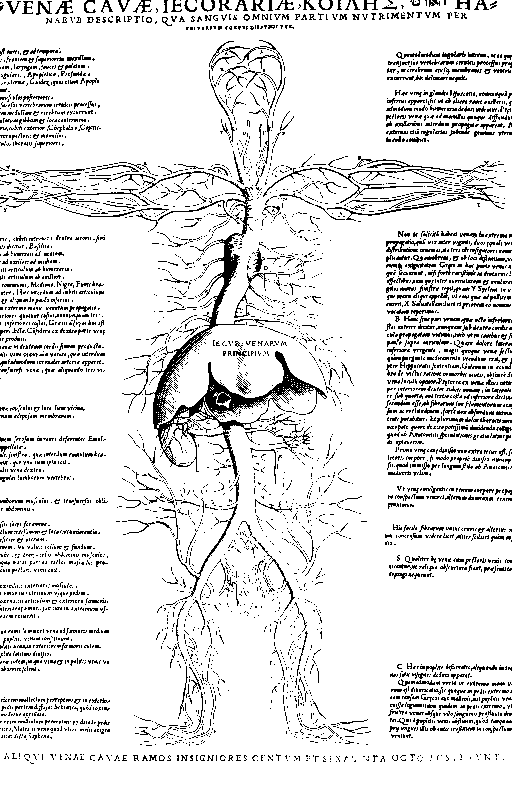
Pre-Vesalian Anatomists
"The stomach itself is surrounded by the spleen and the lobes of liver, which are like hands grasping it. Thus the stomach may receive for stimulation of the black bile by a sort of partnership from the spleen, that portion which the latter does not need for its own use"-- Andres de Laguna, 1535
"The substance of the liver is quite thick since it is nourished by the thickest blood. It is very rarely divided into five lobes; more frequently into four most frequently into three."--Andres de Laguna, 1535
"The spleen is the receptacle for the purging of kite blood from that black humour which we call bile and the Greeks call melancholia"-- Alessandro Benedetti, 1497
"The spleen's substance is soft, thin, and spongy, blacker than the liver. "-- Niccolo Massa, 1559
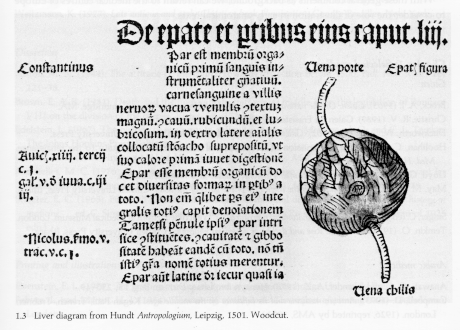
William Harvey, 1653
"Gall bladder [lies in] a hollow of the liver, a sinus carved out."
"Wherefore when blood is prepared from chyle it is separated in the liver."
"The liver [is] in the upper part, right, forward; [the] more noble place for the more noble [organ]. The spleen on the other hand, inferior to the left, to the rear; an ignoble place for the more ignoble [organ]."
"Similarly [according to] other physicians the spleen [is] the receptacle of melancholy as the gall bladder of gall; wherefore the spleen causes one to laugh."
"The liver is branched in some, simple in others."
"The shape of the spleen [is] like the tongue of an ox [or] the sole of the foot; [it is] slightly bowed out on the left side, a little concave on the inner side, toward the stomach. It has an uneven surface and is a little rough with some tubercles."
"Gall bladder: [the shape] of a very long pear compressed from base into neck."
Conclusion
Return to History of the Body Home Page